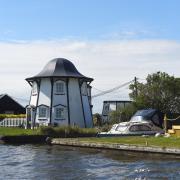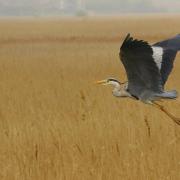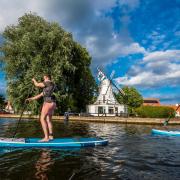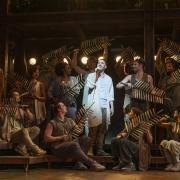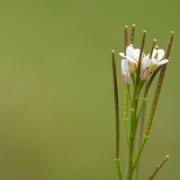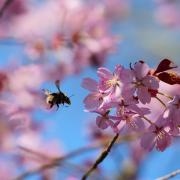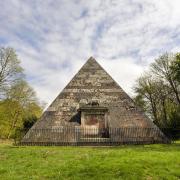From birdwatching to seeing stars, there are lots of reasons to get out and explore the north Norfolk coast during the winter months
Fireworks
Start 2024 with a bang by watching the magnificent New Year’s Day fireworks explode over Cromer Pier at 5pm on January 1.

Beginning with birds
For keen birders, January 1 is the date it all begins again. If you want to try recording every species you see this year then the RSPB reserve at Titchwell is an excellent place to start. Its special morning session is ideal for anyone from beginners (who can hire binoculars at the reserve shop) to experts keen to get the year off to a flying start. Join a guide to spot as many birds as possible – tickets include a field guide list to record your feathered finds.
Titchwell is also good for a wintry walk any day. Paths wind through woodland glades and past freshwater pools and lagoons to the beach. At this time of year look out for vast numbers of geese, down from the Arctic for the winter, shimmering wading birds, flocks of snow bunting, roosting hen and marsh harriers, and short eared and barn owls.
Along the coast Cley Marshes has been a bird sanctuary for almost a century. It was Norfolk Wildlife Trust’s first site and the members of Cley Bird Club will reveal just what a sanctuary it is with an annual bird count on Saturday January 6. All welcome.
A free family fun day at Cley Marshes on Sunday January 7 includes free entry for every child and accompanying adult and free activities in the Norfolk Wildlife Trust education centre.
Wildlife wonder
Sunrise and sunset are the best times to see one of the great winter wildlife spectacles of Norfolk. Huge skeins of pink-footed geese fly from, or to, their overnight roosts. See (and hear – they're very noisy) them at the Norfolk Wildlife Trust reserves at Holme Dunes and Cley Marshes, or from Holkham’s Washington bird hide, a 15-minute walk west of Lady Anne’s Drive.
Coastal path
Walkers can follow the curve of the entire Norfolk coast for an unfurling, unfailing delight of creeks, cliffs, saltmarshes, sand dunes, flint-built fishing villages, sturdy windmills and pastel beach huts. The Norfolk Coast Path stretches from Hunstanton, with its fabulous red-and-white striped cliffs, all the way round to the Suffolk border. Enjoy every mile in an epic multi-day adventure, staying in cosy coastal pubs and hotels en route, or pick a short-walk highlight such as the six-mile circular walk from Sheringham, taking in coast, clifftop and the National Trust’s glorious Sheringham Park. Full details at the Norfolk Trails section of the Norfolk County Council website.

Snowdrops
Drifts of dazzling snowdrops are beginning to light up wintry gardens, woodland and churchyards across the county.
One of best places to see snowdrops is just a few miles inland at Walsingham Abbey, Little Walsingham, where they flow through 18 acres of woodland and riverbank in gardens which include the ruins of an ancient priory and have been a place of pilgrimage for centuries.
The Walsingham snowdrop season begins on January 22 and the gardens will be open daily 10am-4pm until March 3.
Grand estates
Although Holkham Hall and garden are closed until spring, there are still vast tracts of parkland and beach to roam, and perhaps come across red deer, plus well-being walks and a Saturday morning Parkrun.
Along the coast, tucked behind Cromer, is Felbrigg. Again the hall and garden are closed this month, but the parkland is open dawn to dusk, and the shop, café and bookshop open from 10am-3.30pm.
A 2.5 mile forest trail takes in the poignant Victory V avenue of beech trees, planted in in 1946 by the last squire of Felbrigg in memory of his RAF flying officer brother Richard Ketton-Cremer, killed in the Second World War. The walk also passes an 18th century ice house, designed to look like a ruin, a lake, medieval church and oak trees dating back five centuries.
Star-studded sky
Get starry eyed, staring at our dark skies. Long winter nights are ideal for stargazing.
Barrow Common, south of Brancaster, is an official Dark Sky Site. Designated ‘Milky Way Plus’ it means there is a good chance of seeing the Milky Way arching overhead on a clear night.
At the new Hunstanton Observatory, on the pitch and putt course, roll away the roof to reveal the open skies above. It can be booked by groups keen to observe or photograph the night sky.

Seals
More than 4,000 grey seal pups are born on Blakeney Point every winter. They spend their first few weeks snug in white fur coats, part of England’s largest grey seal colony. The first pup was spotted here just 36 years ago. Since then the isolated sand and shingle peninsula has become one of the best places in the world to see baby seals. Surrounded by sea, saltmarsh and mudflats, it is a challenging trek from Cley beach, at any time of the year – which is why the seal boats from Blakeney Quay or nearby Morston are so popular. Most trips begin again in the spring but Beans Boats expects to take people out on January 1, 2 and 3.
READ MORE: Where and when can I see grey seal pups in Norfolk?
God’s graffiti
Explore one of the architectural treasures of the world. Our medieval coastal churches are a marvel – and many are open for passers-by to pop in. Admire the art and architecture, soak up the peaceful atmosphere – or search for centuries-old graffiti. The coastal churches of Blakeney, Cley, Wiveton and Salthouse have some of the finest medieval ship graffiti to be found anywhere in England. Norfolk man Matthew Champion sparked a national movement to find and interpret the designs scratched on to pillars and walls centuries ago and now visible only in certain light. He suggested people might have drawn boats as they prayed for safe sea journeys and deliverance from storms, each little ship sailing sedately across a wall representing a silent plea made solid in stone.

Feast
The north Norfolk coast has two Michelin starred restaurants, in the Neptune, Hunstanton, and Morston Hall near Blakeney – plus Meadowsweet just a few miles inland in Holt.
There are also scores of pubs, and some very fine shops, specialising in the glorious abundance of food grown, made, fished and foraged here. Fish and chips are served year-round and Brancaster mussels and oysters are in season now. Find local meat, vegetables and cheese, season with saffron grown in the Burnhams and pair with wine from a nearby vineyard, cider from north Norfolk orchards or beer made with Norfolk-grown malting barley – renowned as the best in the country.
Barcelona?
Seaside streets stripped of summer crowds are ideal for admiring flamboyant Victorian architecture. Poet John Betjeman called George Skipper the Gaudi of Norfolk and his work includes Hunstanton Town Hall and the towers and domes of the Hotel de Paris in Cromer).
Wild swimming
Come on in – the water’s freezing. Winter sea swimmers enthuse about the exhilaration of slipping in skin-chilling, heart-warming water.
Winter wild swimmers need to acclimatise – but those who continue swimming through the autumn and into winter get empty beaches and an ocean of vitamin sea. Many brave the water in just swimming costumes, hats and neoprene gloves and socks, packing warm clothes and drinks for afterwards.
Winter weirdness
The dark nights and expanses of uninhabited land around our coast create an eerie atmosphere away from the main settlements. There are villages where stories of a devil dog have taken root, marshes where Will o’ Wisps flare, and then there’s Stiffkey, where residents claim a footbridge to the marshes was replaced by fairies.
It might sound unlikely story – but then so did the real life of Rector of Stiffkey, Rev Harold Davidson, defrocked in 1932 for his ministry to prostitutes, who became a circus performer and was mauled to death by a lion in Skegness. The fact the tragedy took place in Skegness seems only the heighten the pathos.

Fossils from the Deep History Coast
Norfolk historian John Davies and paleontologist David Waterhouse transformed a trip to the seaside into an awe-inspiring journey back two million years when they dubbed the north Norfolk coast the Deep History Coast. It includes West Runton where the biggest, oldest and best-preserved steppe mammoth ever found in Britain, emerged from the cliffs 700,000 years after its death. Lions, wolves, bears, rhinos and hyena onceroamed here too.
West Runton beach is generous with its fossils, which crumble from the cliffs or are scoured from the chalk beach. Digging into the cliffs at this site of special scientific interest is forbidden, and dangerous, but low-tide walks along the beach often yield fossil finds.
Music and theatre
Hear live classical music at Wells Maltings as part of the North Norfolk Music Festival winter series.
Beethoven and Schumann are on the programme played by musicians including joint festival director Simon Rowland-Jones and his fellow Yehudi Menuhin School graduate Melvyn Tan.
Georgia Shackleton, of the renowned Shackleton Trio, plays at the Norfolk Wildlife Trust’s Cley Marshes visitor centre on January 19. Her tour of music from her first solo album, Harry’s Seagull, aditional music of East Anglia which has taken her as far afield as Denmark and Switzerland. The Norwich musician will play traditional interpretations
Other theatres along the coast include the Princess Theatre, Hunstanton, Sheringham Little Theatre and the Pavilion Theatre on Cromer Pier.
Sleep well
Quirky coastal accommodation includes Sheringham’s Wee Retreat, a luxury sea-front apartment created from a Victorian toilet block. Cley windmill rises from the coastal marshes, with five stunning storeys of rooms with fabulous views.
The Hippisley Hut in Old Hunstanton is named for Richard Hippisley who helped establish a network of stations to intercept radio signals from the Germany Navy during the First World War. His listening post played a critical role in intercepting German plans ahead of the Battle of Jutland and is now part of a holiday home.
There are more wartime connections at The Blakeney Hotel where Jack Higgins researched The Eagle Has Landed.
All the things you cannot see
One of the many wow factors of our coast is to look north and know there is nothing but ocean and ice between you and the North Pole.
Just off the shore at Holme is one of the great mysteries of Norfolk history. Exactly 4,074 years ago an oak tree was felled, up-ended and surrounded by a circle of 55 wooden posts hewn from more oaks.
It might have been a temple or a place where dead bodies were exposed to the elements and picked clean by birds as part of ancient funeral rituals.
Eventually the sea engulfed the site and the henge was hidden for more than 4,000 years. After it was exposed again the central stump and many of the surrounding posts were removed for preservation and display in Lynn Museum.
But there is another henge out there, dating back to the same prehistoric spring.
Further east lies the underwater wonder of the world’s longest chalk reef, formed 100 million years ago between Weybourne and Happisburgh. Its astonishing towers and arches are visible only to divers – and inhabitants including eight-tentacled, colour-changing, ink-squirting cuttlefish.







